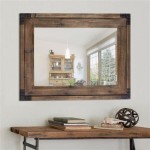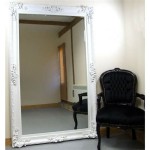Can You Cut A Mirror With A Grinder? A Comprehensive Guide
The question of whether one can cut a mirror with a grinder is a common one, often arising in the context of DIY projects, renovations, and artistic endeavors. The answer, while seemingly simple, involves a nuanced understanding of the tools involved, the materials being cut, and the safety precautions necessary. This article will explore the feasibility of cutting a mirror with a grinder, outlining the appropriate methods, potential risks, and alternative approaches that may be more suitable.
Mirrors, by their nature, are fragile objects. They consist of a sheet of glass coated with a reflective material, typically silver or aluminum, on one side. The glass itself, while generally strong in compression, is vulnerable to chipping and shattering under tensile stress, especially when subjected to concentrated force or rapid temperature changes. Grinders, conversely, are powerful tools designed for cutting, grinding, and polishing various materials, including metal, stone, and concrete. Their high-speed rotating abrasive discs generate significant heat and vibration, making them potentially unsuitable for delicate tasks like cutting mirrors, unless specific precautions are meticulously followed.
The primary reason for caution when attempting to cut a mirror with a grinder lies in the inherent risk of causing the glass to shatter. The uncontrolled vibration and heat generated by the grinder can easily induce stress fractures in the glass, leading to unpredictable breakage. Furthermore, the abrasive disc can chip the edges of the mirror, resulting in an uneven and aesthetically unappealing finish. The reflective coating on the back of the mirror can also be damaged by the heat and friction, further compromising the mirror's integrity.
Understanding the Risks and Challenges
Several factors contribute to the challenges associated with cutting a mirror with a grinder. Firstly, the type of grinder being used is a crucial consideration. Angle grinders, for instance, are generally too powerful and aggressive for this task. The high rotational speed and coarse abrasive discs of angle grinders are more likely to cause shattering than to produce a clean cut. A smaller, more precise tool, such as a rotary tool with a specialized cutting disc, offers greater control and reduces the risk of damage. Furthermore, the type of cutting disc is equally important. A standard grinding disc designed for metal or stone is entirely unsuitable for cutting glass. Instead, a diamond-tipped cutting wheel specifically designed for glass or tile should be used. These wheels are thinner and have a finer abrasive grit, minimizing the risk of chipping and shattering.
Secondly, the condition of the mirror itself plays a significant role. A mirror with existing chips, cracks, or scratches is far more likely to shatter when subjected to the vibration and heat of a grinder. Similarly, the thickness of the glass can impact its susceptibility to breakage. Thicker glass is generally more resistant to cracking than thinner glass, but it also requires more effort and precision to cut cleanly. The reflective coating on the back of the mirror can also pose a challenge. If the coating is already peeling or damaged, it can further weaken the glass and increase the likelihood of shattering.
Thirdly, the technique employed is paramount. Attempting to force the grinder through the mirror will almost certainly result in breakage. Instead, a slow, steady, and controlled approach is essential. The grinder should be held at a shallow angle to the surface of the mirror and moved gradually along the intended cutting line. Applying excessive pressure should be avoided, as this can generate excessive heat and vibration. Intermittent pauses may be necessary to allow the glass to cool down and prevent overheating. The cutting process should be performed in a well-ventilated area to minimize the inhalation of glass dust and reflective coating particles.
Essential Safety Precautions
Safety is of utmost importance when working with grinders and glass. Several safety precautions should be taken to minimize the risk of injury. Firstly, always wear appropriate personal protective equipment (PPE), including safety glasses, a dust mask, and gloves. Safety glasses will protect the eyes from flying glass shards and abrasive particles, while a dust mask will prevent the inhalation of harmful dust. Gloves will provide a better grip on the mirror and protect the hands from cuts and abrasions. It is also advisable to wear hearing protection, as grinders can be quite loud, especially when cutting hard materials like glass.
Secondly, ensure that the work area is well-lit and free from obstructions. Clutter and poor visibility can increase the risk of accidents. The mirror should be placed on a stable and non-slip surface to prevent it from moving during the cutting process. A rubber mat or a piece of carpet can provide additional cushioning and grip. Clamps or other securing devices can also be used to hold the mirror in place, but care should be taken not to overtighten them, as this could crack the glass.
Thirdly, practice proper tool handling and maintenance. Before using a grinder, thoroughly inspect it for any signs of damage or wear. Ensure that the cutting disc is securely attached and in good condition. Follow the manufacturer's instructions for operating and maintaining the grinder. Never use a grinder with a damaged power cord or a malfunctioning switch. Regularly clean the grinder to remove dust and debris, and lubricate moving parts as needed. If you are unfamiliar with the operation of a grinder, seek instruction from a qualified professional before attempting to use it.
Alternative Methods for Cutting Mirrors
Given the inherent risks associated with cutting a mirror with a grinder, it is often advisable to explore alternative methods that may be safer and more effective. One common alternative is to use a glass cutter. A glass cutter is a simple hand tool with a small, hardened steel or carbide wheel that is used to score the surface of the glass. After scoring the glass along the desired cutting line, pressure is applied to break it along the score. This method is generally less likely to cause shattering than using a grinder, but it still requires practice and skill to achieve a clean and accurate cut.
Another alternative is to use a wet saw with a diamond blade. Wet saws are commonly used for cutting tile, but they can also be used to cut glass. The water helps to cool the blade and lubricate the cut, reducing the risk of chipping and shattering. Wet saws provide a cleaner and more precise cut than glass cutters, but they are also more expensive and require a dedicated workspace with a water supply. Furthermore, wet saws can be quite messy, as they generate a significant amount of water spray.
A third option is to hire a professional glass cutter. Professional glass cutters have the experience, skills, and specialized equipment necessary to cut mirrors safely and accurately. They can also handle complex shapes and sizes that may be difficult to cut using other methods. While hiring a professional may be more expensive than attempting to cut the mirror yourself, it can save time, effort, and the potential cost of replacing a shattered mirror. When choosing a professional glass cutter, it is important to select one with a good reputation and a proven track record of quality workmanship.
In summary, while it is technically possible to cut a mirror with a grinder, it is not generally recommended due to the high risk of shattering and injury. Alternative methods, such as using a glass cutter or a wet saw, are typically safer and more effective. If you choose to attempt cutting a mirror with a grinder, it is essential to take all necessary safety precautions and to use the appropriate tools and techniques. However, for the best results and minimal risk, consider seeking the assistance of a qualified professional.
How To Cut Convex Futura Mirrors Replace Broken Ones

Cutting Glass With A Cutter Or Without It Learn The Ropes

Joy Of Mirror Making Rough Grinding

How To Cut Glass With A Dremel Follow These Easy Steps

How To Cut Glass With A Dremel Follow These Easy Steps
Joy Of Mirror Making Rough Grinding

Rough Grinding A 20 Quartz Telescope Mirror On The Fixed Post Machine

Using A Grinder To Cut Glass Is It Effective Helper

Rough Grinding A 20 Quartz Telescope Mirror On The Fixed Post Machine

5 Golden Rules To Cut Glass Tiles Correctly By Using A Diamond Blade On An Electric Wet Saw Montolit








